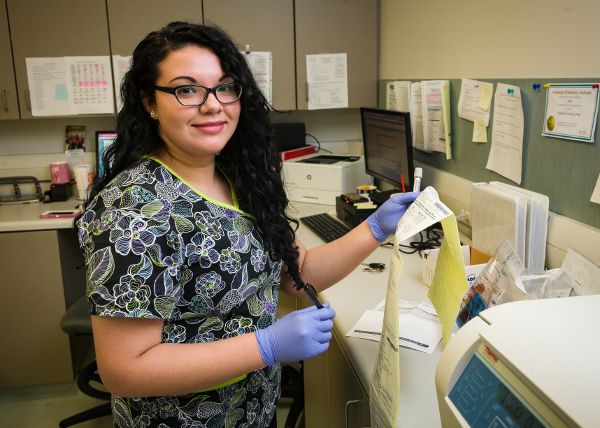Overview
Myelodysplastic syndromes (MDS) begin when blood-forming cells in the bone marrow start to behave abnormally, leading to defective functioning and low counts of certain blood cells. MDS is considered a form of cancer, and about 1 in 3 MDS patients develop acute myeloid leukemia (AML), a type of cancer of the bone marrow. Myeloproliferative disorders are a related group of conditions.
Bone marrow, the tissue found in the center of large bones, contains blood-forming cells including stem cells. These blood-forming cells manufacture red blood cells, white blood cells, and platelets.
Types of myelodysplastic syndromes include:
- MDS with multilineage dysplasia (MDS-MLD): this is the most common type
- MDS with single lineage dysplasia (MDS-SLD)
- MDS with ring sideroblasts (MDS-RS)
- MDS with excess blasts (MDS-EB)
- MDS with isolated del(5q)
- MDS, unclassifiable (MDS-U)
MDS can also be divided into primary MDS, in which the underlying cause is not known, or secondary MDS, in which prior cancer treatment, existing bone marrow disease, or another factor may be identified as the cause. Primary MDS is more common.
Symptoms
The main symptom of MDS is low blood cell counts, which can be detected by blood tests with or without associated symptoms. MDS symptoms may include:
- Anemia, or too few red blood cells
- Fatigue
- Dizziness
- Weakness
- Shortness of breath
- Pale skin
- Leukopenia, or too few normal white blood cells
- Frequent or more severe infection
- Thrombocytopenia, or too few blood platelets
- Easy bruising or bleeding
- Frequent or more severe nosebleeds or gum bleeding
- Other symptoms
- Unintended weight loss
- Fever
- Pain in the bones
- Loss of appetite
It is important to note that the symptoms above can be caused by a number of other non-cancerous causes, but it is important to be checked by a medical professional to improve the chances of effective treatment.
Risk Factors
The risk of MDS increases with advanced age: most cases occur in people older than 70, and MDS is uncommon in people younger than 50. MDS is more common in men than in women, which may be partially explained by associated differences in other risk factors like higher rates of smoking among men.
People who have undergone prior cancer treatment may be at higher risk for developing secondary MDS. Certain chemotherapy medications, including mechlorethamine, procarbazine, chlorambucil, cyclophosphamide, ifosfamide, etoposide, teniposide, and doxorubicin, may increase the risk of MDS, though this risk varies based on dosages and types of drugs used in treatment. Chemotherapy combined with radiation treatment increases MDS risk further, and stem cell transplants including high chemotherapy doses may also be at elevated risk. It is important to note, however, that only a small percentage of people who receive these cancer treatments develop MDS.
Smoking increases the risk of MDS as well as many other types of cancer. Exposure to high-dose radiation or certain chemicals including benzene and certain substances used in petroleum and rubber manufacturing are also associated with increased rates of MDS.
Certain conditions can increase the risk of developing MDS, including:
- A family history of MDS
- Fanconi anemia
- Shwachman-Diamond syndrome
- Diamond Blackfan anemia
- Familial platelet disorder with a propensity to myeloid malignancy
- Severe congenital neutropenia
- Dyskeratosis congenita
Prevention
While some risk factors, such as gender, hereditary conditions, and age cannot be controlled, there may be some things you can do to lower your risk of MDS:
- Refrain from or stop smoking.
- Avoid exposure to benzene and other known carcinogenic chemicals.
- Thoroughly discuss the benefits and risks of proposed chemotherapy medications with your doctor. Usually, these treatments’ life-saving benefits outweigh the minor risk of secondary MDS, but research on how to limit risk associated with these treatments is ongoing.
Diagnosis
While some myelodysplastic syndromes are found after symptoms appear, many people are diagnosed based on the results of blood tests performed for other reasons. If there is a suspicion of MDS, additional lab testing will be performed. This will include a complete blood count (CBC), and may include other blood tests to rule out alternative diagnoses like iron deficiency anemia.
A bone marrow aspiration and biopsy is usually required to confirm a diagnosis of MDS. In the aspiration procedure, a sample of bone marrow is removed from the hip bone under local anesthetic via a thin needle. The biopsy procedure involves removal of a small piece of bone as well as the marrow, with a slightly larger needle; it often follows a bone marrow aspiration. A pathologist or hematologist will then examine the samples for abnormalities to determine diagnosis.
Other tests, including flow cytometry, immunocytochemistry, and chromosome testing, may be used in addition to the diagnostic tools discussed above.
Treatment
The treatment plan will depend on the stage of the cancer, as well as other factors. Our doctors will work closely with you and your family determine the best treatment plan for you. Options for treatment could include:
- Supportive therapy
- Growth factors
- Chemotherapy
- Stem cell transplant
Your doctor may decide more than one of these treatment options will be in your best interest. Stem cell transplant is often the best option for those who are good candidates. Supportive care such as blood transfusions are important to treatment and often used in combination with other methods.







